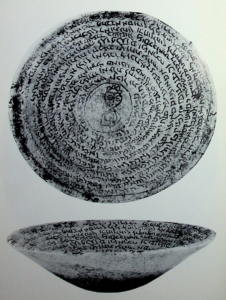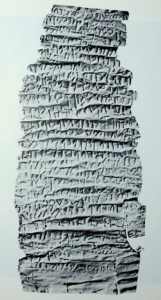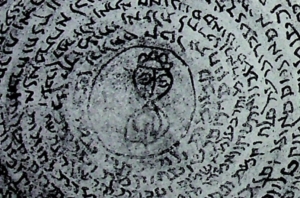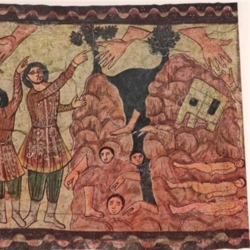The following is a reconstruction of this historiola made from the text found in an amulet bowl (12a) held in the collection of the National Library of Israel, and from the text of a silver amulet (№15) purchased by the Israel Museum in 1969. The translation is lightly adapted from the critical translation offered for both amulets by Joseph Naveh and Shaul Shaked.[3] find Naveh and Shaked’s, Amulet and Magic Bowls: Aramaic Incantations of Late Antiquity (Brill 1985), pp. 104-122 and 188-197.
| Source (Aramaic) | Translation (English) |
|---|---|
[חדה] סממית ילידת תרי עשר בנין וכולהון קטל יתהון סדרוס רשיעה |
One Smamit[4] lit. spider or lizard. Cf. Proverbs 30:28. A reference to a tiny, weak-seeming creature that achieves seemingly insurmountable deeds. (Thanks to Isaac Mayer for this reference.) A famous story to this effect is told in the Alphabet of ben Sira in answer to the question of Nebuchadnezzar, “Why has God created in His world wasps and spiders, which only cause harm and do nothing beneficial?” whereupon ben Sira relates to him a story of a fugitive David successfully eluding the soldiers of King Shaul searching for him thanks to a web spun by a spider sent by God for that purpose. But who is this Smamit? An illustration in Bowl 12a appears to me to show the bust of a figure wearing a crown. Is this an illustration of Smamit or that of her tormentor? gave birth to twelve sons. All of them were killed by Sideros[5] σῐ́δηρος — Gk. iron. The name of the antagonist here is suggestive of their power, as of a weapon forged of iron — in other words, a dangerous man. But the name is also strange given the use of iron in prophylactic wards for childbirth (see below). As such, is Sideros an eponymous name offered suggesting this story is an etiology for such widespread magic? the Wicked. |
וקמת וערקת מן קדומוהי ואזלת לחד טורא דימיחד בעלמא שמיה [בראש. בנת לה בית ברא ונתן לה תרעין דפרזלא]. ועבדת לחרשין דינחשה ועבדין דפרזלא [וטרדת בא]. |
She got up and fled from him,[6] In other versions of the story, it is made clear that she flees to her sanctuary after becoming pregnant again. Who is the father though? Is it Sideros himself? What are we to learn from the terrifying irony of Smamit opening her door to these three travelers (an act of good will) that she is once again victimized. That no good deed goes unpunished? Or is it that the place that she fled to, at the top of the world, was vulnerable for reasons she had not even imagined: due to it being a gateway for these angelic and demonic entities. We can only speculate. The bare bones of the tale in the historiola leave many questions. and she went to [the top of] a mountain whose name is unique in the world[7] Even if this is not a reference to the Har haBayit, it is interesting to note the rule forbidding the use of iron tools in building there (I Kings 6:7) in relation to the magical valence of iron in this story. Also find in Gittin 68a.9, a certain mountain upon which the king of the Shedim, Ashmodai, ascends from and descends to in his commute to and from the celestial Yeshiva, and upon which he has dug his well (or cistern) for refreshing his thirst with water. The story has other interesting parallels with this one. [and built a house for herself. She provided it with gates of iron.] She performed sorceries of copper and magic acts of iron [and she locked it].[8] Cf. Jeremiah 6:28. Fetters of iron and copper/bronze are mentioned as a device to restrain demonic beings in other amulets, as Shaked and Naveh note in their Appendix to Amulet 15 (footnote 2, p. 111): “The magic combination ‘iron and copper’ occurs in Amulet 11:6-7 (see Shaked & Naveh p.90) and in Montgomery 1913, No. 19:10 (see Montgomery p. 195).” They also note (footnote 23, p. 160): “The use of iron for the protection of a woman at child-birth is very widespread. The earliest attestation in Jewish literature seems to be in Tosefta Shabbat 7:3 והקושר ברזל בכרעי המיטה של חיה … הרי זה מדרכי האמרי: see Lieberman 1961/2. p. 84. See further Blau 1898, pp. 159 f. For ethnological data on the Jews of Afghanistan Brauer 1944. p. 337; on Jewish practice in Karlsruhe. Scheftelowitz 1920, p. 77. In nineteenth-century Poland iron was used for the protection of women at child-birth with the explanation that Heb. barzel represented the initial letters of Bilha, Rachel, Zilpa and Lea (Jahrbuch für jüd. Volkskunde A. 1923, p. 217; Trachtenberg 1939, p. 313, n. 14). We have information about the magic use of iron in child-birth, e.g. among Armenians (Hambroer 1962. pp. 32 ff.. 105 ff.) and among Arabs in Morocco (Westermarck 1926. index s.v. iron, steel). On the efficacy of iron against demons in general see Abt 1908. pp. 159 f., where further literature is given; Doutté 1908, pp. 41 ff.; Goldziher 1907; and Trachtenberg 1939.” |
ואתא סאוני וססאוני וסניגלי וארתיקו ואמרו לה פתח לנא ואמרת להון לית אנא פתחא לכון ואמרו דוכתא דנעבר וניעול עלה |
There came Saoni and Sasaoni and Sanigli.[9] Sanigli is the name as it appears in Amulet 15, chosen here in place of סנגרו (Senagro) in the Jerusalem bowl 12a because Amulet 15 is thought to be the older of the two sources, and because, with the ל, it seems to me more phonetically similar to the name Semanglaf, attested in later sources. They knocked[10] v’artiqo, a word in Galilean Aramaic whose meaning was mistaken by the scribe of the bowl as the name of one of the helpers. and said to her: “Open for us.” She said to them: “I shall not open for you.” They said: “This is a place (for us) to pass through and enter into.”[11] The text remains ambiguous whether these travelers are human or angel. The place upon which Smamit built her sanctuary atop this unique mountaintop appears to have also been a doorway by which these three must travel (perhaps between worlds, as it were). |
וקמת ופתחת להון ועול עימהון סדרוס וקטליה ליברה וחנק יותיה |
She stood up and opened for them. With them there came in Sideros. He killed her son and strangled him. |
וקמת וצוחת עלוהי אסאוני וססאוני וסניגלי מא עבדו ליה. |
She stood up and cried over him: “O Saoni and Sasaoni and Sanigli! What have they done to him?” |
[הכין שמע סדרוס ופחת וערק מנהון.] |
(They then addressed themselves to God in prayer.)[12] Later versions of this story have the three pray to God at this point. This appears to also be hinted at in our texts, as Shaked and Naveh note, “The spelling אסאוני in the Jerusalem and Hilprecht bowls [12a and 12b, respectively] suggests the Greek vocative participle attached to the name in the appropriate syntactic situation, which makes it possible that there existed a Greek Vorlage from which the Aramaic version derived. The Greek text of Perdrizet 1922 indeed has a vocative form of address at this point.” In their appendix to Amulet 15 they quote: “Τότε οί άγιοι προσευχήν ποιήσαντες προς θεόν, κατήλθεν άγγελος εξ ουρανού και είπεν αύτοίς ˙ εισηκούσθη ή δέησις υμών προς Θεόν ˙ καταδιώξατε αυτήν εις τά μέρη του Λιβάνου.” (The saints [Sisinios, Sinēs, and Sēnodōros] then addressed themselves to God in prayer, and an angel came down from heaven and said to them: “Your petition has been heard by God. Pursue her [the demon Gyllou] as far as the Lebanon.”) — in Negolium perambulans in tenebris. Etudes de démonologie gréco-orientale Paul Perdrizet, 1922 (Publications de la Faculté des Lettres de l’Université de Strasbourg, fasc. 6) Strasbourg. (Many thanks to Maria Vamvakidou for proofreading my Greek!) [Sideros heard, opened (the gate), and fled from them.] |
וקומו [מן חזין] ורדפו בתריה ואדריכו יותיה לגו פלגוס ימא רבה ובעו מינהון למיקטל יותיה ולמיחנק יותיה |
They stood up and [having seen (him), they] chased him and led him[13] or found him into the midst of the great sea, Pélagos,[14] πέλᾰγος — standard Greek for “sea.” I wonder whether the borrowing here might not hint at a more specific geography, especially given the proximity of a place named Pelagos to a sanctuary of Poseidon as found in Pausanias’ Description of Greece 8.11.1 — μετὰ δὲ τὸ ἱερὸν τοῦ Ποσειδῶνος χωρίον ὑποδέξεταί σε δρυῶν πλῆρες, καλούμενον Πέλαγος, καὶ ἐκ Μαντινείας ἡ ἐς Τεγέαν ὁδὸς φέρει διὰ τῶν δρυῶν. Μαντινεῦσι δὲ ὅροι πρὸς Τεγεάτας εἰσὶν ὁ περιφερὴς ἐν τῇ λεωφόρῳ βωμός. εἰ δὲ ἀπὸ τοῦ ἱεροῦ τοῦ Ποσειδῶνος ἐς ἀριστερὰν ἐκτραπῆναι θελήσειας, σταδίους τε ἥξεις μάλιστά που πέντε καὶ ἐπὶ τῶν Πελίου θυγατέρων ἀφίξῃ τοὺς τάφους: ταύτας φασὶν οἱ Μαντινεῖς μετοικῆσαι παρὰ σφᾶς, τὰ ἐπὶ τῷ θανάτῳ τοῦ πατρὸς ὀνείδη φευγούσας. (“After the sanctuary of Poseidon you will come to a place full of oak trees, called Pelagos (“Sea”), and the road from Mantineia to Tegea leads through the oaks. The boundary between Mantineia and Tegea is the round altar on the highroad. If you will turn aside to the left from the sanctuary of Poseidon, you will reach, after going just about five stades, the graves of the daughters of Pelias. These, the Mantineans say, came to live with them when they were fleeing from the scandal at their father’s death.”) and they sought of them to kill him and strangle him. |
ואמר להון שבוקו מיני ואנא מישתבענא לכון במִי־מָדַד בְּשָׁעֳלוֹ מַיִם וְשָׁמַיִם בַּזֶּרֶת תִּכֵּן וְכָל בַּשָּׁלִשׁ עֲפַר הָאָרֶץ וְשָׁקַל בַּפֶּלֶס הָרִים וּגְבָעוֹת בְּמֹאזְנָיִם דכל אתר דדכרין שמיה דסאוני וססאוני וסניגלי אנא לא איקטול ולא איחנוק ולא איחבול בביתיה דפלוני בר פלוני וכל בנין דאית להון ודהון להון לפלונית בת פלונית ופלוני בר פלוני |
He said to them: “Let go of me, and I swear to you in the name of the one ‘who has measured the water in the hollow of his hand and meted out heaven with the span, and comprehended the dust of the earth in a measure, and weighed the mountains with a scale and the hills in a balance?’ (Isaiah 40:12), that wherever the name of Saoni and Sasaoni and Sanigli is mentioned I shall have pity and shall not kill or strangle or injure in the house of Ploni son of Ploni and any children whom they — Plonit daughter of Plonit and Ploni son of Ploni — have and will have. |
ברוך אתה יייי אל קים מלך העולם יגער הרוחות מלפניך |
Blessed are you YHVH El Ḳayam, cosmic majesty. May you exorcise the ruḥot[15] lit. spirits, i.e., harmful, demonic entities (rather than spirits of the dead). from your presence. |
אסירא ליליתא אסירא מבכלתא אסיר שתא אסיר [ ] אסיר [ ] אסיר זבנא אסיר פתכרא אסירין כל מזיקין בישין דאית בביתיה דפלוני בר פלוני [ ] שִׁשִּׁים גִּבֹּרִים סָבִיב לָהּ מִגִּבֹּרֵי יִשְׂרָאֵל׃ כֻּלָּם אֲחֻזֵי חֶרֶב מְלֻמְּדֵי מִלְחָמָה אִישׁ חַרְבּוֹ עַל־יְרֵכוֹ מִפַּחַד בַּלֵּילּוֹת׃ |
Bound is Lilit, bound is Mevakalta, bound is Sheta bound is […] bound is […] bound is Zavna,[16] meaning uncertain. The first letters זב are reconstructed by Shaked and Naveh. Ernest Klein’s Etymological Dictionary notes, “Aram.-Syr. זְבַן (= he bought), which is prob. borrowed from Akka. zibānītu (= balance, pair of scales).” bound is the “idol,” bound are all the maziḳin who are in the house of Ploni son of Ploni… “Sixty valiant men are around about it, of the mighty men of Yisrael, all girt with swords, and expert in war, every man has his sword upon his thigh, because of the fear by night” (Song of Songs 3:7-8). |
The tale of Smamit was widely dispersed in many languages, but our reconstruction here is based primarily on Amulet Bowl 12a (Jerusalem, Heb. 4° 6079, NLI), supplemented by the text of the silver Amulet 15 (Israel Museum) and the notes of Joseph Naveh and Shaul Shaked. (Text in brackets is added from the text transcribed from Amulet 15 and their notes.) For the unreconstructed text, find Naveh and Shaked’s, Amulet and Magic Bowls: Aramaic Incantations of Late Antiquity (Brill 1985), pp. 104-122 and 188-197.
For related tales of vulnerable women, find the story of Lot’s Daughters (Genesis 18:17-19:29, which also involves mysterious traveling visitors), and the story of the Pilegesh b’Givah (Judges chapters 19-21, in which there are no visitors). For a related tale or possible derivation, find this historiola involving Eliyahu haNavi and Lilith.
Source(s)
Notes
| 1 | also romanized as Semanglof. There are additional variant spellings in the Hebrew texts, for example סמנגכלף in the Maḥzor Vitry. |
|---|---|
| 2 | alternately, סנגרו (Senagro) as their name appears in the Jerusalem Amulet Bowl 12a. |
| 3 | find Naveh and Shaked’s, Amulet and Magic Bowls: Aramaic Incantations of Late Antiquity (Brill 1985), pp. 104-122 and 188-197. |
| 4 | lit. spider or lizard. Cf. Proverbs 30:28. A reference to a tiny, weak-seeming creature that achieves seemingly insurmountable deeds. (Thanks to Isaac Mayer for this reference.) A famous story to this effect is told in the Alphabet of ben Sira in answer to the question of Nebuchadnezzar, “Why has God created in His world wasps and spiders, which only cause harm and do nothing beneficial?” whereupon ben Sira relates to him a story of a fugitive David successfully eluding the soldiers of King Shaul searching for him thanks to a web spun by a spider sent by God for that purpose. But who is this Smamit? An illustration in Bowl 12a appears to me to show the bust of a figure wearing a crown. Is this an illustration of Smamit or that of her tormentor? |
| 5 | σῐ́δηρος — Gk. iron. The name of the antagonist here is suggestive of their power, as of a weapon forged of iron — in other words, a dangerous man. But the name is also strange given the use of iron in prophylactic wards for childbirth (see below). As such, is Sideros an eponymous name offered suggesting this story is an etiology for such widespread magic? |
| 6 | In other versions of the story, it is made clear that she flees to her sanctuary after becoming pregnant again. Who is the father though? Is it Sideros himself? What are we to learn from the terrifying irony of Smamit opening her door to these three travelers (an act of good will) that she is once again victimized. That no good deed goes unpunished? Or is it that the place that she fled to, at the top of the world, was vulnerable for reasons she had not even imagined: due to it being a gateway for these angelic and demonic entities. We can only speculate. The bare bones of the tale in the historiola leave many questions. |
| 7 | Even if this is not a reference to the Har haBayit, it is interesting to note the rule forbidding the use of iron tools in building there (I Kings 6:7) in relation to the magical valence of iron in this story. Also find in Gittin 68a.9, a certain mountain upon which the king of the Shedim, Ashmodai, ascends from and descends to in his commute to and from the celestial Yeshiva, and upon which he has dug his well (or cistern) for refreshing his thirst with water. The story has other interesting parallels with this one. |
| 8 | Cf. Jeremiah 6:28. Fetters of iron and copper/bronze are mentioned as a device to restrain demonic beings in other amulets, as Shaked and Naveh note in their Appendix to Amulet 15 (footnote 2, p. 111): “The magic combination ‘iron and copper’ occurs in Amulet 11:6-7 (see Shaked & Naveh p.90) and in Montgomery 1913, No. 19:10 (see Montgomery p. 195).” They also note (footnote 23, p. 160): “The use of iron for the protection of a woman at child-birth is very widespread. The earliest attestation in Jewish literature seems to be in Tosefta Shabbat 7:3 והקושר ברזל בכרעי המיטה של חיה … הרי זה מדרכי האמרי: see Lieberman 1961/2. p. 84. See further Blau 1898, pp. 159 f. For ethnological data on the Jews of Afghanistan Brauer 1944. p. 337; on Jewish practice in Karlsruhe. Scheftelowitz 1920, p. 77. In nineteenth-century Poland iron was used for the protection of women at child-birth with the explanation that Heb. barzel represented the initial letters of Bilha, Rachel, Zilpa and Lea (Jahrbuch für jüd. Volkskunde A. 1923, p. 217; Trachtenberg 1939, p. 313, n. 14). We have information about the magic use of iron in child-birth, e.g. among Armenians (Hambroer 1962. pp. 32 ff.. 105 ff.) and among Arabs in Morocco (Westermarck 1926. index s.v. iron, steel). On the efficacy of iron against demons in general see Abt 1908. pp. 159 f., where further literature is given; Doutté 1908, pp. 41 ff.; Goldziher 1907; and Trachtenberg 1939.” |
| 9 | Sanigli is the name as it appears in Amulet 15, chosen here in place of סנגרו (Senagro) in the Jerusalem bowl 12a because Amulet 15 is thought to be the older of the two sources, and because, with the ל, it seems to me more phonetically similar to the name Semanglaf, attested in later sources. |
| 10 | v’artiqo, a word in Galilean Aramaic whose meaning was mistaken by the scribe of the bowl as the name of one of the helpers. |
| 11 | The text remains ambiguous whether these travelers are human or angel. The place upon which Smamit built her sanctuary atop this unique mountaintop appears to have also been a doorway by which these three must travel (perhaps between worlds, as it were). |
| 12 | Later versions of this story have the three pray to God at this point. This appears to also be hinted at in our texts, as Shaked and Naveh note, “The spelling אסאוני in the Jerusalem and Hilprecht bowls [12a and 12b, respectively] suggests the Greek vocative participle attached to the name in the appropriate syntactic situation, which makes it possible that there existed a Greek Vorlage from which the Aramaic version derived. The Greek text of Perdrizet 1922 indeed has a vocative form of address at this point.” In their appendix to Amulet 15 they quote: “Τότε οί άγιοι προσευχήν ποιήσαντες προς θεόν, κατήλθεν άγγελος εξ ουρανού και είπεν αύτοίς ˙ εισηκούσθη ή δέησις υμών προς Θεόν ˙ καταδιώξατε αυτήν εις τά μέρη του Λιβάνου.” (The saints [Sisinios, Sinēs, and Sēnodōros] then addressed themselves to God in prayer, and an angel came down from heaven and said to them: “Your petition has been heard by God. Pursue her [the demon Gyllou] as far as the Lebanon.”) — in Negolium perambulans in tenebris. Etudes de démonologie gréco-orientale Paul Perdrizet, 1922 (Publications de la Faculté des Lettres de l’Université de Strasbourg, fasc. 6) Strasbourg. (Many thanks to Maria Vamvakidou for proofreading my Greek!) |
| 13 | or found him |
| 14 | πέλᾰγος — standard Greek for “sea.” I wonder whether the borrowing here might not hint at a more specific geography, especially given the proximity of a place named Pelagos to a sanctuary of Poseidon as found in Pausanias’ Description of Greece 8.11.1 — μετὰ δὲ τὸ ἱερὸν τοῦ Ποσειδῶνος χωρίον ὑποδέξεταί σε δρυῶν πλῆρες, καλούμενον Πέλαγος, καὶ ἐκ Μαντινείας ἡ ἐς Τεγέαν ὁδὸς φέρει διὰ τῶν δρυῶν. Μαντινεῦσι δὲ ὅροι πρὸς Τεγεάτας εἰσὶν ὁ περιφερὴς ἐν τῇ λεωφόρῳ βωμός. εἰ δὲ ἀπὸ τοῦ ἱεροῦ τοῦ Ποσειδῶνος ἐς ἀριστερὰν ἐκτραπῆναι θελήσειας, σταδίους τε ἥξεις μάλιστά που πέντε καὶ ἐπὶ τῶν Πελίου θυγατέρων ἀφίξῃ τοὺς τάφους: ταύτας φασὶν οἱ Μαντινεῖς μετοικῆσαι παρὰ σφᾶς, τὰ ἐπὶ τῷ θανάτῳ τοῦ πατρὸς ὀνείδη φευγούσας. (“After the sanctuary of Poseidon you will come to a place full of oak trees, called Pelagos (“Sea”), and the road from Mantineia to Tegea leads through the oaks. The boundary between Mantineia and Tegea is the round altar on the highroad. If you will turn aside to the left from the sanctuary of Poseidon, you will reach, after going just about five stades, the graves of the daughters of Pelias. These, the Mantineans say, came to live with them when they were fleeing from the scandal at their father’s death.”) |
| 15 | lit. spirits, i.e., harmful, demonic entities (rather than spirits of the dead). |
| 16 | meaning uncertain. The first letters זב are reconstructed by Shaked and Naveh. Ernest Klein’s Etymological Dictionary notes, “Aram.-Syr. זְבַן (= he bought), which is prob. borrowed from Akka. zibānītu (= balance, pair of scales).” |

“היסטוריולה של סממית וסידרוס | Historiola of Smamit and Sideros, a reconstruction based on Amulet 15 & Amulet Bowl 12a” is shared through the Open Siddur Project with a Creative Commons Attribution-ShareAlike 4.0 International copyleft license.




![[Ḳameʻ] : [ʻavur Mirḳada d.m Ṿiadah bat Donah] (Columbia University Hebrew Manuscripts Collection, MS General 194) - cropped](https://opensiddur.org/wp-content/uploads/2020/08/ldpd_11683790_000_00000001-featured-image.jpg)







Leave a Reply